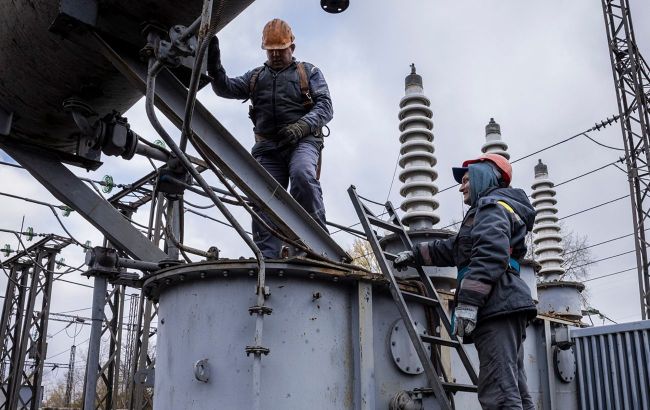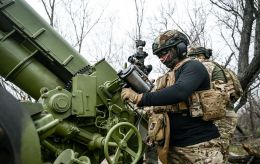Ukraine's power grid situation in winter and potential impact of Russian missile strike
 Restoration of power facilities in Ukraine (photo: Getty Images)
Restoration of power facilities in Ukraine (photo: Getty Images)
The Ukrainian power system has passed the resilience test. The first peak of cold weather was passed without emergency assistance and power outages. However, new periods of temperature drops are possible until March. Blackouts are possible if there is no way to cover the electricity deficit. Under what circumstances such a scenario can be realized and who will be cut off first, read the RBC-Ukraine article to find out.
The material was prepared based on official reports of Ukrenergo and the Ministry of Energy and public and exclusive comments of state-owned companies and officials.
Ukraine survived the first half of January with extremely low temperatures and snowfall without any major problems in the power system. Electricity generation was sufficient, and no serious accidents occurred due to the technical condition of power facilities. And most importantly, there were no massive attacks on generation facilities and distribution networks.
"The recent shelling did not cause any serious damage to the Ukrainian power system. The situation is under control, there is a safety margin, and no scheduled outages are expected," says Prime Minister Denys Shmyhal.
The situation with shelling has changed significantly compared to last year. Until mid-January last year, Ukraine's power system was subjected to massive shelling 12 times. As a result, the level of electricity supply dropped to 60%, and blackout schedules were introduced across the country.
"The fact that we have no outages and the situation is much better than a year ago is the result of the fact that there is no such large-scale destruction, and we continue to restore," says Volodymyr Kudrytskyi, CEO of Ukrenergo.
The temperature drop in 2024 began after the New Year holidays. At the end of the first decade of January, the frost increased at night, sometimes up to 27 degrees. Due to the sharp temperature drop and snow accumulation, power grids were cut off. As a result, some settlements in Kirovohrad, Dnipropetrovsk, Odesa, Mykolaiv, and other regions of Ukraine lost power supply.
However, most accidents, mainly on power lines, were eliminated within a day. In general, according to Kudrytskyi, the power system operated stably. "There were no severe consequences from the attacks with Shaheds and missiles. We can say that there were no terrible catastrophic results. Difficulties arose due to weather conditions in the regions," he says.
Ukraine survived the peak of cold weather without emergency assistance
Ukraine survived the peak of cold weather in early January even without emergency aid from Europe. It was requested from our partners only three times over the winter - in December when 7 heat generation units were put out of commission. But the repair schedules were adjusted, and now this situation will not happen again, Energy Minister Herman Halushchenko tells RBC-Ukraine.
According to Kudrytskyi, the power system was balanced during cold weather by increasing thermal and hydro generation. However, hydro capacities are not enough for long. "The peculiarity of hydro is that its resource cannot be used for a long time - the accumulated water is enough for several days. We treat this resource sparingly," says the CEO of Ukrenergo.
After the accumulated water is "discharged" to generate electricity, its supply needs to be restored. Ukrhidroenergo reports that to prevent an emergency in the integrated power system of Ukraine, HPPs and PSPPs are operating normally using the maximum available capacity to cover peak consumption levels during the period of lower temperatures. "All the equipment of the company's stations is now fully ready to work during the next cold snap," the company says.
According to Halushchenko, there is no reason to be concerned. "As for hydro generation, everything depends on the water level. Today, we can say that we have accumulated water and have the opportunity (to use it again - ed.)," the Energy Minister says in a comment to the agency.
During the period of low temperatures, when the deficit reached 2.5% of the total demand, the balance was maintained, among other things, by importing electricity from Slovakia and Romania. On the most difficult days - January 9 and 10 - according to Ukrenergo, the deficit reached 582 MW in some hours. Moreover, the peak consumption periods were not only in the morning and evening but also during the day.
 Graphics by Ukrenergo
Graphics by Ukrenergo
But the business often imported electricity when it was most needed for the balance sheet. Most of the purchases were made during the day when the price of electricity was lower than that of the Ukrainian resource. According to Halushchenko, the volume of imports could be increased, as its potential has never been fully utilized.
The technical possibility of importing electricity from Europe to Ukraine and Moldova is 1700 MW. "Business has started importing more, there are hours when it is more profitable than buying from us (in Ukraine - ed.). But we have not yet chosen a 1.7 GW cap. We have this resource, and we have approved all the incentives for business," Halushchenko says.
According to him, if the situation becomes more complicated, imports can be increased to normalize the balance. "But I don't see a situation where imports will be needed to save the day," the Minister says.
Will it be possible to avoid blackouts?
So far, we can say that the power system passed the first test of strength in early January. But cold snaps are still expected until March. "We will probably have several cold periods in January, February, and possibly March. These are the periods when the enemy can potentially attack Ukraine and, in particular, the energy sector. Then there may be more discomfort," Kudrytskyi says.
Emergency measures are envisaged in case of a shortage. First of all, Ukraine can turn to its European partners for emergency assistance. But these small volumes will not save the situation in case of a large deficit. The second tool is disconnecting consumers. According to Halushchenko, industrial enterprises will be cut off first.
"We will start with emergency aid, and then we may cut off the industry. The population is the last to be cut off," Halushchenko tells RBC-Ukraine. Given the experience of last year, he notes that regional governors know the situation and will be guided in selecting facilities to limit power supply. They will shut down enterprises that did not import electricity, the government source tells the agency.
The management of these facilities should be prepared for possible restrictions, as the government last year gave guarantees of uninterrupted power supply only to those companies that import 50% of electricity consumption.
However, even if the situation escalates due to the shelling, the risk of serious power supply problems is still not very high. "The only thing that can affect the system is attacks. And not even the attacks, but the level of destruction caused by them," notes Halushchenko.
But today, generation facilities are much more protected than last year. Power transmission systems may be damaged. But Ukrainian power engineers have experience restoring them even in combat conditions. We have a reserve of autotransformers, which caused the most serious problems last year. Moreover, the equipment continues to be delivered to Ukraine.
Ukrenergo says that there is a certain safety margin. But it is not as large as we would like, so they ask us to save electricity. The effect of savings can reach 200-400 MW, which is equal to the generation of several thermal power units.
Experts believe the risks of a serious deterioration in the power supply situation are low. "If the temperature stays below 20 degrees for a week or more, there will be a 2 GW generation deficit during peak hours. Imports and emergency assistance can cover 1.7 GW. That is, a shortage is theoretically possible," says Hennadii Riabtsev, director of the Psychea Center.
But even under such circumstances, stabilization outage schedules for the industry may be introduced in case of serious damage to power facilities due to shelling or simultaneous emergency shutdown of 5-7 power units of thermal power plants.
So far, Russia has not launched any major attacks on energy facilities, but this does not mean that it is not monitoring the state of the Ukrainian energy sector. According to Vadym Skibitskyi, a representative of the Defense Ministry's Main Intelligence Directorate, Russia analyzed the power system's structures in 2022-2023 and identified the most critical facilities that could be affected.
Now, according to intelligence, the enemy continues to regularly conduct satellite imagery of Ukraine's energy facilities, so the threat to them remains.

